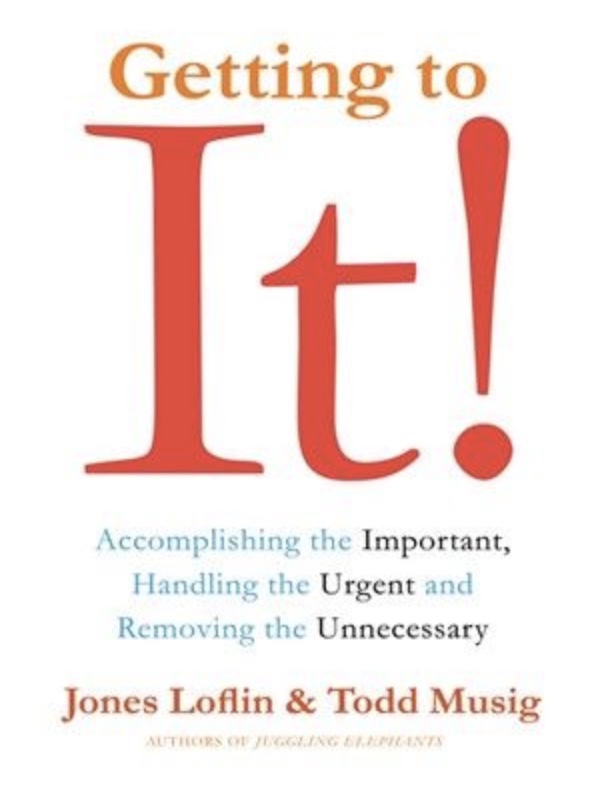Key Quote
“What price are you paying for allowing things of lesser importance to dominate your schedule instead of spending more time on those you care most about?” (p. 18). — Jones Loflin and Todd Musig
Key Points
Defining IT. We all have a funnel with a wide entrance but a narrow exit into which we allow goals and obligations. Develop a filter to sift through all the “input” and possibilities you allow to enter your funnel and choose the things that align with your values, goals, responsibilities, and resources. Consider both immediate and long-term aims, and understand that you will have to say “no” to things that aren’t in sync with your goals.
Believing IT. Remove negativity along with counterproductive people and attitudes, and will yourself to engage not just your head but your heart in your ITs. “Visualize the benefits of working on and accomplishing IT” (p. 77).
Communicating IT. “Communicating your values, goals, and activities creates a framework of support that helps you in your quest to achieve what is most important to you” (p. 83). Develop accountability with others, and while pursuing your IT, encourage others as they pursue theirs!
Planning for IT. Once you have decided on an IT, break the planning down into both “general steps” and “milestones.” Account for “established realities you cannot ignore or remove” and obstacles you may have to face along the way (pp. 104, 101). Create a plan to achieve your IT, and as you go, do not forget what the authors call the four Ds: “delegate, delete, delay,” and “do” (p. 120). “A plan improves spontaneity or creativity around it” (p. 118).
Doing IT. Organize your environment – your workspace, health, finances, etc. – around achieving your IT and removing distractions. Arrange your life for your IT as if you are a school kid laying out your clothes and gear to leave the house on time for the first day of school the next morning. And remember, “Failure at an IT is often better than success at something else” (p. 130).
After Accomplishing IT. “The journey may be more valuable than the IT itself” (p. 157). Celebrate and enjoy your accomplishments and others’ accomplishments, as well. Reward yourself and the team, and review what you have learned. Finally, after some reward and relaxation, move on.
Doing IT Again. As you prepare to move forward to new ITs, consider what has been waiting in the wings as possible new ITs, especially relationships. Take time to reflect before you assume what your next IT should be. “The value of a course correction or adjustment cannot be overstated” (p. 179).
Working With Others on IT. Usually, achieving an IT requires at least some collaboration and teamwork with others. Communicate faithfully, set a shared vision, encourage feedback throughout the process, and be on guard for erosion or distractions from the IT.
Wrapping IT Up. Going forward, continue on the IT journey. “A successful life is a succession of successful ITs” (p. 210).
Key Concepts:
Time Management
Be realistic about what you can accomplish in an hour or a day.
Create gaps or buffers of time in case things take longer than initially anticipated
“Not having a plan also contributes to your failing to get your priorities accomplished.” The authors go on to say, “If you don’t determine the most important use of your time and act accordingly, something less desirable will consume it”
(pp. 13, 14).
To get started defining your IT, you need to take a moment to step back and reflect. “Let you first IT be to STOP” (p. 22).
Some questions to ask yourself as you evaluate what your IT is:
“What criteria or process did I use to determine the tasks that exist in my funnel today? Am I solely reacting to the priorities of others?
Are these actions really important to moving my work or life forward?”
“Do I see possibilities that have little or no connection to what I view as my priorities now?”
“On what basis did I choose the tasks I performed a few hours ago? Yesterday?” (p. 24).
Take stock of your values, your goals, your passions, and don’t forget what you are actually being paid to do!
“Ultimately, you will have to say no to the possibilities recommended by others that don’t align with your filters” (p. 44).
Distractions & Multitasking
It’s not possible to divide attention between two conscious tasks at once. Your brain will only let you make one conscious decision at a time.
“Multitasking is one of the most overused and misunderstood practices in the workplace nowadays. It originated as a computer-engineering term, and it’s often touted as a way for people to get more done in less time. People flaunt their ability to multitask – as if their job performance can be measured in floating-point operations per second – when, for human beings, dividing our attention can often be detrimental to our natural way of getting tasks done well, or at all” (pp. 136-137).
Too many tasks at once can be problematic. “Task saturation” is a term coined by the Air Force to describe how aviators experience “stress-based paralysis” when given too many tasks. A significant number of aircraft crashes are attributed to this (p. 138).
“Interestingly enough, if you give a computer too many tasks, it starts ‘thrashing,’ which basically means it spends an overwhelming amount of time just trying to figure out how to organize the requests it’s supposed to process and not actually completing any of them. Sound familiar?” (p. 137).
Measure the time you spend on your IT to help you be mindful of if you are genuinely making your IT a priority. Ask yourself, “What activities are getting the bulk of my time? Are they IT for me by choice?” and “What activities can be eliminated to allow more room for IT?” (p. 143).
Your lifestyle is the foundation of your IT. Your number one IT should be your health in terms of nutrition, sleep, personal time, and exercise. “Take care of yourself so you can take care of IT” (p. 146).
Course Corrections
You might have to reevaluate your thinking, realign your plans, or even redefine your IT.
“Sometimes a fresh point of view, a differing opinion, or a recommendation can be just what you need to jump-start your next IT” (p. 183).
Take regular breaks to step back and determine if you are off course or need to re-evaluate your IT. “The value of a course correction or adjustment cannot be overstated. In fact, the busier you are, the more important it is to take stock of the conditions around you and see how they affect your choice of IT. Remember: the Titanic sank in large part because it was moving so quickly that it could not make changes in time to avoid the iceberg” (p. 178).
Wrapping-Up Projects
When you are concluding a project or goal, it is essential to “debrief” and go over what you have learned along the way (p. 162).
“Create a punch list.” Model yourself after good contractors who “make punch lists – lists all of the little things that need to be wrapped up before closing out a project” (p. 165).
“The items on this list are usually the icing on the cake, the fine details that really put the finishing touches on the project. Items might include touching up paint on a bedroom wall, adjusting a cabinet door so it closes correctly, or straightening a light fixture in the bathroom. You should do the same with your IT” (p. 165).
As you wrap up your project, it is also important to “clear your head and prepare for what’s next”(p. 166). “Take an intermission” before moving to another project to “rest,” “replenish,” reflect, and “refocus” (pp. 166-167).
Commit yourself to “continuous progress.” Continue to review, seek and reflect on feedback, critique and improve, and plan again. The journey is ongoing!
Loflin, J. & Musig, T. (2013) Getting to it! Accomplishing the Important, Handling the Urgent, and Removing the Unnecessary. New York: HarperCollins.

“Task saturation” is a term coined by the Air Force to describe how aviators experience “stress-based paralysis” when given too many tasks. A significant number of aircraft crashes are attributed to this.
